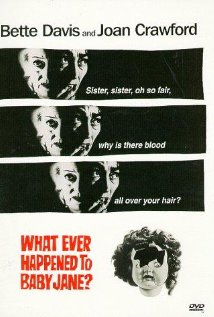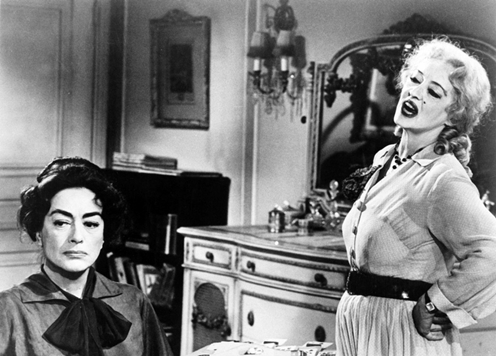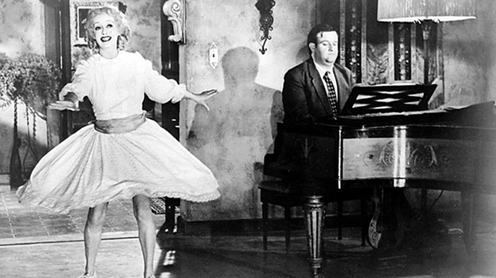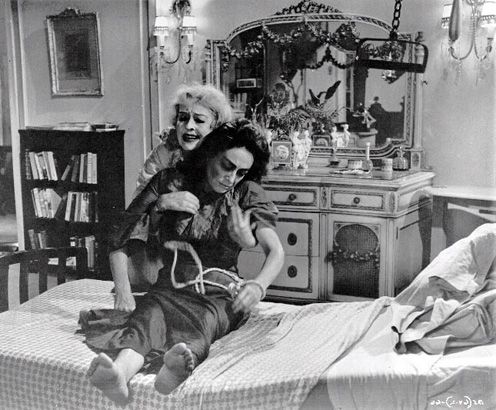 What Ever Happened to Baby Jane?/1962/Warner Bros., et al/134 min.
What Ever Happened to Baby Jane?/1962/Warner Bros., et al/134 min.
Rocking the season of festive joy and family fun is always easier when you actually like your relatives. On the other hand, unresolved issues have a pesky perseverance, sort of like Aunt Milly’s traditional fruitcake that never leaves the fridge.
A case in point is “What Ever Happened to Baby Jane?” (1962, Robert Aldrich), a classic dark-humor domestic noir. In the movie, Sisters Blanche and Jane Hudson, two retired Golden Age actresses, are in dire need of a good therapist to help them navigate the layers of self-delusion and address the serious damage done by their rather warped parents.
“Baby Jane,” which stars the inimitable Joan Crawford and Bette Davis, was the only film in which these two supreme screen divas and stalwarts of film noir ever played together. Both were strong, gutsy, competitive actresses who didn’t shy away from a fight, especially with each other. The back story of longtime rivals Bette and Joan plotting battles and butting heads, literally and figuratively, is almost as famous as the movie itself. Nevertheless, their difficult offscreen relationship infuses the film with a delicious tension.
Davis is Baby Jane Hudson, a vaudeville child star whose talent expired when she hit puberty. Crawford plays Blanche Hudson, who, as an adult, became a highly regarded and popular Hollywood actress until a mysterious car accident ended her career.

Sisters Blanche (Joan Crawford) and Jane Hudson (Bette Davis) are two retired Golden Age actresses navigating a tormented relationship.
Confined to a wheelchair, dignified and gracious Blanche lives in a sprawling house. Jane, bitter and brassy and long forgotten by her fans, has nowhere else to go so she tends to Blanche as best she can – in between guzzling bottles of gin and scotch. And she’s planning a comeback, reprising her decades-old hit song “I’m Writing a Letter to Daddy” with the help of a blubbery, unctuous ne’er-do-well musician named Edwin Flagg (Victor Buono).
Realizing that Jane is losing it, Blanche plans to sell the house, get some psychiatric help for baby sis and live in a smaller abode with their kind, caring housekeeper Elvira (Maidie Norman). Think Jane’s going for that? Not bloody likely.
Thus the stage is set for Crawford and Davis to duke it out, including a scene where Davis reportedly kicked Crawford’s forehead and stitches were required. Crawford retaliated by putting weights in her pockets for the scene in which Davis had to haul her around, spurring back trouble for Davis. So much for mellowing with age. As Davis once remarked, “Old age is no place for sissies.”
Other gossipy asides: Knowing that Crawford was on Pepsi-Cola Co.’s board of directors (a result of her marriage to the firm’s chairman and CEO Alfred Steele, from 1956 until his death in 1959), Davis had a Coke machine hauled on to the set.
Davis arranged for her daughter Barbara Merrill (later known as B.D. Hyman) to play a small role as teenage neighbor Liza Bates. Crawford carped about Babs’ acting ability, which was not exactly in abundant supply.
(And some trivia: Liza’s mom, Mrs. Bates, was played by Anna Lee, who played Bronwyn in 1941’s “How Green Was My Valley” and much later Mrs. Quartermaine on the TV soap “General Hospital.”)
For years, some critics sneered at “Baby Jane” calling it exploitative, campy, far-fetched and too long. Admittedly, it’s medium budget and there is a key plot point that turns on a very creaky hinge. But who cares? The chance to watch Davis dive into her role as grotesque Baby Jane with such pure relish and to see Crawford’s restrained, reined-in performance in the far less showy, perhaps more challenging, part of self-contained victim Blanche is an absolute delight. The supporting cast sparkles as well.

Victor Buono plays the unctuous ne’er-do-well musician named Edwin Flagg who is helping Baby Jane relaunch her career.
For all the glorious moments of black comedy, hats off to Lukas Heller’s script from the Henry Farrell novel. Ernest Haller received an Oscar nod for his luscious cinematography.
Following in the footsteps of Billy Wilder and “Sunset Blvd.,” Aldrich masterfully paints this sympathetic portrait of losers and those left behind by the Hollywood machine. And in the reversal at the finale, despite the arch humor throughout, Aldrich probes the poignant depths of a sibling relationship – evoking long-simmering feelings of resentment and guilt, regret and sadness.
Jane’s evil mind-games are chilling and her telephone impersonations of Blanche are hilarious. But what’s most unforgettable and perhaps most brave of Davis is Jane’s dreadful appearance. Her rat’s nest of bleached-blonde curls appears to be groomed on an annual basis. Jane’s caked-on cupid’s bow mouth and heavy bands of jet-black liner apparently made Davis cry when she finally saw herself onscreen. Davis described it as the look of a woman who never bothered to remove her makeup from day to day but simply kept adding more.
Would FNB dare to choose sides between these pioneers of female power, these bastions of bitchiness? Well of course she would! Team Joan is clearly the way to go. Disciplined, determined and driven, Crawford fought tooth and nail for everything she ever had. And she proved to have better business sense than Davis, asking for a percentage of “Baby Jane’s” profit whereas Davis settled for a flat fee. Last but not least, Crawford apparently tried to befriend an unreceptive Davis before the cameras started rolling.
The Warner Brothers DVD edition has a disc of extra goodies, including a short documentary comparing the careers of Davis and Crawford; a Turner bio feature of Davis, narrated by Jodie Foster; a clip of Davis on a ’70s TV show singing “What Ever Happened to Baby Jane?” and wearing a perfectly horrid old-lady dress; and a British TV interview with Crawford, looking and sounding as regal as the queen.
So, pop some corn, roast some chestnuts and gather the family to watch this delicious dysfunction. Happy holidays, everyone!











From FNB readers